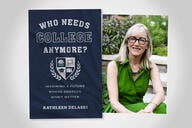You have /5 articles left.
Sign up for a free account or log in.
Twin pressures on colleges to release more student- and consumer-friendly information -- to be more accountable to the public and to create an alternative to magazine rankings perceived as excessively based on reputation -- are manifesting themselves with new online databases from the U.S. Department of Education and from colleges themselves, as presidents have increasingly stated the importance of defining the metrics by which they are measured.
Meanwhile, college leaders at a Tuesday conference, "Beyond Ranking: Responding to the Call for Useful Information," sponsored by an admissions reform group, the Education Conservancy, stressed a need to go even further. Colleges, participants in the conference said, shouldn't just provide information to the passive seeker, but also encourage self-assessment on the part of applicants and a more interactive admissions process over all.
The Department of Education’s newly revamped college search Web site, now called College Navigator, offers a robust search engine allowing students to find and compare colleges based on everything from sports teams to states to SAT scores (the newly designed site, however, does not include any new information, beyond what was available on the department's old College Opportunities Online Locator, because of statutory limits on data collection).
Additionally, the National Association of Independent Colleges and Universities (NAICU), which has challenged the Bush administration's efforts to expand its data collection activities in higher education, today launches its own consumer-friendly Web site, the University and College Accountability Network (U-CAN), comprised of profiles of hundreds of private colleges.
The new online resources come as deliberate responses to the Secretary of Education’s Commission on the Future of Higher Education, which released a report calling for greater accountability and transparency on the part of colleges one year ago today. And they come also as college leaders discuss how they can provide better information to counter what many of them -- including those involved with the Education Conservancy -- see as the undue and inappropriate influence of the US News and World Report rankings.
“Too many decisions about higher education -- from those made by policy makers to those made by students and families -- rely heavily on reputation and rankings derived to a large extent from inputs such as financial resources rather than outcomes,” the Spellings Commission’s report notes. “Better data about real performance and lifelong working and learning ability is absolutely essential if we are to meet national needs and improve institutional performance.”
The Education Department’s latest effort does not include the information on student outcomes that became a focus of the commission's report, and of the department's campaign to alter federal rules governing accreditation, because it has not been authorized by Congress to collect it. But “they're doing all they can with the data they have,” said Charles Miller, the commission’s chairman. The College Navigator site updates the department’s COOL database which, the department’s Vickie L. Schray said, simply “was not very cool. You basically had to be a statistician to get in there and manipulate the information to answer some very critical questions for students and families.”
The department designed College Navigator with the input of 11 focus groups in eight states, with the search engine geared toward providing the information that students said they were seeking. The department found that low-income and first-generation students in particular, Schray cited as one example, were very interested in searching by geography to get a comprehensive list of institutions located nearby. Students can search the site using such varied characteristics as tuition, program or major, campus setting, size, the availability of distance education or credit for life experience, religious affiliation and institution type. Visitors to the site can view data from up to four colleges in side-by-side comparisons.
Meanwhile, NAICU’s new U-CAN Web site, online as of today, aims to provide comparable data while emphasizing the distinctiveness of each individual institution, said David L. Warren, the association’s president.
About 600 of NAICU's nearly 1,000 member colleges have signed up so far to post profiles based on a common template (also developed with the help of focus groups) that features admissions, enrollment and graduation data -- with the specific metrics defined uniformly by the association -- in addition to somewhat more difficult-to-find information like average undergraduate loan burden at graduation, average net tuition and undergraduate class size. Each profile also includes a narrative describing what makes a university unique, and a large number of hyperlinks throughout connect students to the university’s home page, where they can find more information on everything from transfer of credit policy to internships to study abroad.
“In the end, the board voted to move forward with the template in part because colleges have the opportunity to distinguish themselves,” Warren said. “This tries to humanize the process, tries to simplify the process. I think it does those things without losing the vital data or complexity."
NAICU’s U-CAN site, which lacks the extensive search and on-screen comparison functions of the Education Department’s College Navigator (although Warren said more precise search capabilities could be added based on user feedback), deliberately does not include comparable information on student outcomes out of respect for varying institutional missions. Following a link, "For More About Our Students" on Elon University’s profile, for example, takes a user to data from Elon's National Survey of Student Engagement (NSSE) results. But colleges can link to whatever they find appropriate in that same spot on the template, not just their NSSE scores. “What we have opposed is any prescriptive outcome measure," Warren said.
Miller, the Spellings Commission chair, however, criticized the private college group's approach for limitations in search and comparability. “They’re making an effort to act like they’re making progress and personally it doesn’t seem like much progress to me,” Miller said. “They’ve been the biggest opponent to real transparency, that entity has, so I just have skepticism about them being transparent.”
Yet, participating private college leaders seemed to appreciate U-CAN's combination of the qualitative and quantitative. Douglas C. Bennett, president of Indiana's Earlham College, praised the NAICU and Department of Education resources alike as good first steps in an audio press conference following the Education Conservancy's "Beyond Ranking" conference at Yale University Tuesday. “They’re tremendous steps forward, they’re much more useful than things we’ve had in the past, but we need to do even better than that. They end up being fairly passive measures that project information to students," Bennett said.
The 100 participants at the Yale conference brainstormed about strategies for designing self-assessment measures that would challenge prospective students to approach the admissions process more actively, Bennett and others said. While participants in the news conference were vague on details, generally speaking, Bennett explained, there should be some formal mechanism through which students ask themselves questions like, "What kind of person am I? What kinds of things make me comfortable, what kinds of things challenge me, what’s my growth path, who am I as I go to college?"
”“We feel that is so important to move from a passive model of consumption, of buying a product off the shelf as it were," said Kenyon College President S. Georgia Nugent. "That as educators we can and we should emphasize that education is not a product that you buy, it’s an activity that we engage in.”




